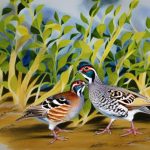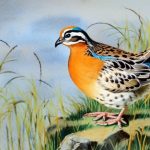Quail breeding has become increasingly popular in Australia due to the high demand for quail meat and eggs in the market. Quail are small, ground-dwelling birds that are relatively easy to care for and can be bred in a small space, making them an ideal choice for small-scale farmers and hobbyists. In addition to their small size, quail are also known for their fast growth rate and high egg production, making them a profitable option for those looking to enter the poultry industry.
Quail breeding in Australia has gained traction due to the increasing interest in sustainable and ethical farming practices. Quail are known for their low environmental impact, as they require less space, feed, and water compared to other poultry species. This makes them an attractive option for farmers looking to minimize their ecological footprint while still reaping the benefits of poultry farming. With the right knowledge and resources, quail breeding can be a rewarding venture for individuals looking to diversify their farming operations or start a new business.
Table of Contents
- 1 Selecting the Right Quail Species for Breeding
- 2 Creating the Ideal Environment for Quail Breeding
- 3 Understanding Quail Reproduction and Egg Incubation
- 4 Managing Quail Chicks and Juveniles
- 5 Health and Nutrition Considerations for Breeding Quail
- 6 Legal and Regulatory Considerations for Quail Breeding in Australia
- 7 FAQs
- 7.1 What is the best environment for breeding quail in Australia?
- 7.2 What do quail eat and how should they be fed during breeding?
- 7.3 How long does it take for quail eggs to hatch?
- 7.4 What are the key considerations for breeding quail in Australia?
- 7.5 What are the common challenges in breeding quail in Australia?
- 7.6 Are there specific regulations or guidelines for breeding quail in Australia?
Key Takeaways
- Quail breeding is a popular practice in Australia, offering a sustainable source of meat and eggs.
- Selecting the right quail species is crucial for successful breeding, with considerations for temperament, egg production, and climate adaptability.
- Creating an ideal environment for quail breeding involves providing adequate space, proper ventilation, and suitable nesting areas.
- Understanding quail reproduction and egg incubation is essential for maximizing hatch rates and ensuring the health of the chicks.
- Proper management of quail chicks and juveniles includes providing a balanced diet, adequate space, and protection from predators.
Selecting the Right Quail Species for Breeding
When it comes to quail breeding, selecting the right species is crucial for success. In Australia, the most common quail species bred for meat and eggs are the Japanese quail (Coturnix japonica) and the Bobwhite quail (Colinus virginianus). Both species are known for their fast growth rate, high egg production, and adaptability to various environmental conditions, making them ideal choices for breeding.
The Japanese quail, also known as the Coturnix quail, is the most popular species for commercial quail farming in Australia. They are known for their high egg production, with each hen laying up to 300 eggs per year. Japanese quail are also prized for their meat, which is lean and flavorful, making them a popular choice for gourmet dishes. On the other hand, the Bobwhite quail is known for its distinctive call and is often bred for hunting purposes. They are also valued for their meat and eggs, although they may not be as prolific as Japanese quail in terms of egg production.
When selecting a quail species for breeding, it’s important to consider factors such as egg production, growth rate, temperament, and adaptability to local climate conditions. By choosing the right species, breeders can maximize their productivity and profitability in the quail farming industry.
Creating the Ideal Environment for Quail Breeding
Creating the ideal environment for quail breeding is essential for the health and productivity of the birds. Quail are ground-dwelling birds that require a clean and spacious living area with access to food, water, and shelter. When setting up a quail breeding operation, it’s important to provide a suitable housing structure that protects the birds from predators and extreme weather conditions.
Quail housing can range from simple wire cages to more elaborate aviaries or barns, depending on the scale of the operation. The housing should be well-ventilated to prevent moisture buildup and respiratory issues in the birds. Additionally, providing nesting boxes or areas where the quail can lay their eggs will help ensure a steady supply of fertile eggs for breeding purposes.
In addition to housing, creating the ideal environment for quail breeding also involves providing a balanced diet and access to clean water. Quail require a high-protein diet to support their rapid growth and egg production, so feed should be formulated specifically for quail or game birds. Clean water should be available at all times to prevent dehydration and ensure optimal health and productivity in the birds.
Understanding Quail Reproduction and Egg Incubation
Understanding quail reproduction and egg incubation is essential for successful breeding operations. Quail reach sexual maturity at around 6-8 weeks of age, at which point they will begin laying eggs. The reproductive cycle of quail is influenced by factors such as day length, temperature, and nutrition, so it’s important to provide optimal conditions to encourage regular egg production.
Once the quail have laid eggs, breeders can collect the eggs for incubation. Quail eggs typically have an incubation period of 17-18 days, during which they require consistent temperature and humidity levels to develop properly. Using a reliable egg incubator with automatic turning capabilities can help ensure a high hatch rate and healthy chicks.
During incubation, it’s important to monitor the temperature and humidity levels closely to prevent any fluctuations that could negatively impact the developing embryos. Turning the eggs several times a day will also help ensure proper development and prevent the embryos from sticking to the shell membrane.
After the incubation period, the quail chicks will begin hatching, and it’s important to provide them with a warm and safe environment to thrive. Understanding the reproductive cycle of quail and proper egg incubation techniques is crucial for maintaining a healthy breeding operation and ensuring a steady supply of chicks for future production.
Managing Quail Chicks and Juveniles
Managing quail chicks and juveniles requires careful attention to their housing, nutrition, and health needs. Quail chicks are delicate and require a warm environment with access to clean water and high-quality chick starter feed. Providing a brooder with a heat source such as a heat lamp or heating pad will help maintain the ideal temperature for the chicks’ growth and development.
As the quail chicks grow into juveniles, they will need more space and access to outdoor areas where they can exercise and forage. Transitioning them to larger housing structures or outdoor pens will help them acclimate to their natural environment and develop strong muscles and bones.
In addition to housing and exercise, managing quail chicks and juveniles also involves monitoring their health and nutrition needs. Regularly checking for signs of illness or injury and providing appropriate veterinary care will help ensure the overall well-being of the birds. Additionally, providing a balanced diet with access to grit and calcium supplements will support healthy growth and egg production in future breeding stock.
By carefully managing quail chicks and juveniles from hatching to maturity, breeders can ensure a steady supply of healthy birds for meat and egg production.
Health and Nutrition Considerations for Breeding Quail

Maintaining the health and nutrition of breeding quail is essential for ensuring optimal productivity and profitability in a breeding operation. Quail require a balanced diet that is high in protein to support their rapid growth and egg production. Commercially formulated quail feed or game bird feed should be provided to meet their nutritional needs.
In addition to a balanced diet, providing access to clean water at all times is crucial for preventing dehydration and supporting overall health in quail. Water should be free from contaminants and changed regularly to prevent bacterial growth.
Regular health checks should also be conducted to monitor the well-being of the birds and identify any signs of illness or disease. Common health issues in quail include respiratory infections, parasites, and nutritional deficiencies, so it’s important to address any concerns promptly with appropriate veterinary care.
Preventative measures such as vaccination programs and biosecurity protocols can also help minimize the risk of disease outbreaks in a breeding operation. By prioritizing the health and nutrition of breeding quail, breeders can ensure a sustainable and profitable venture in the poultry industry.
Legal and Regulatory Considerations for Quail Breeding in Australia
When engaging in quail breeding in Australia, it’s important to be aware of the legal and regulatory considerations that govern poultry farming operations. Depending on the scale of the operation, breeders may need to obtain permits or licenses from local authorities to breed quail for commercial purposes.
In addition to permits, breeders must also comply with animal welfare regulations that govern the housing, transportation, and handling of quail. Providing suitable living conditions that meet industry standards for space, ventilation, and cleanliness is essential for ensuring compliance with animal welfare laws.
Furthermore, breeders must adhere to food safety regulations when selling quail meat or eggs to consumers. This may involve implementing quality control measures such as regular testing for contaminants or pathogens in the products.
By staying informed about legal and regulatory considerations for quail breeding in Australia, breeders can ensure that their operations are compliant with industry standards and contribute to sustainable and ethical farming practices in the poultry industry.
If you’re interested in breeding quail in Australia, you may also want to check out this informative article on mating season for turkeys. Understanding the mating behaviors and seasons of different poultry can provide valuable insights for successful breeding and raising of birds.
FAQs
What is the best environment for breeding quail in Australia?
Quail thrive in a well-ventilated and clean environment with access to natural light. They require a temperature-controlled space with proper bedding and nesting areas.
What do quail eat and how should they be fed during breeding?
Quail are omnivores and can be fed a diet of commercial quail feed, supplemented with fresh greens, grains, and insects. During breeding, it is important to provide a high-protein diet to support egg production and chick development.
How long does it take for quail eggs to hatch?
Quail eggs typically take 16-18 days to hatch, depending on the specific breed and environmental conditions.
What are the key considerations for breeding quail in Australia?
Key considerations for breeding quail in Australia include obtaining the necessary permits and licenses, providing a suitable breeding environment, ensuring proper nutrition and care for the quail, and understanding the breeding and incubation process.
What are the common challenges in breeding quail in Australia?
Common challenges in breeding quail in Australia include maintaining optimal environmental conditions, preventing disease and parasites, and managing the breeding and incubation process to ensure successful hatching and chick survival.
Are there specific regulations or guidelines for breeding quail in Australia?
Yes, there are specific regulations and guidelines for breeding quail in Australia, including requirements for obtaining permits and licenses, as well as standards for housing, care, and welfare of the quail. It is important to research and comply with these regulations before starting a quail breeding operation.
Meet Walter, the feathered-friend fanatic of Florida! Nestled in the sunshine state, Walter struts through life with his feathered companions, clucking his way to happiness. With a coop that’s fancier than a five-star hotel, he’s the Don Juan of the chicken world. When he’s not teaching his hens to do the cha-cha, you’ll find him in a heated debate with his prized rooster, Sir Clucks-a-Lot. Walter’s poultry passion is no yolk; he’s the sunny-side-up guy you never knew you needed in your flock of friends!







